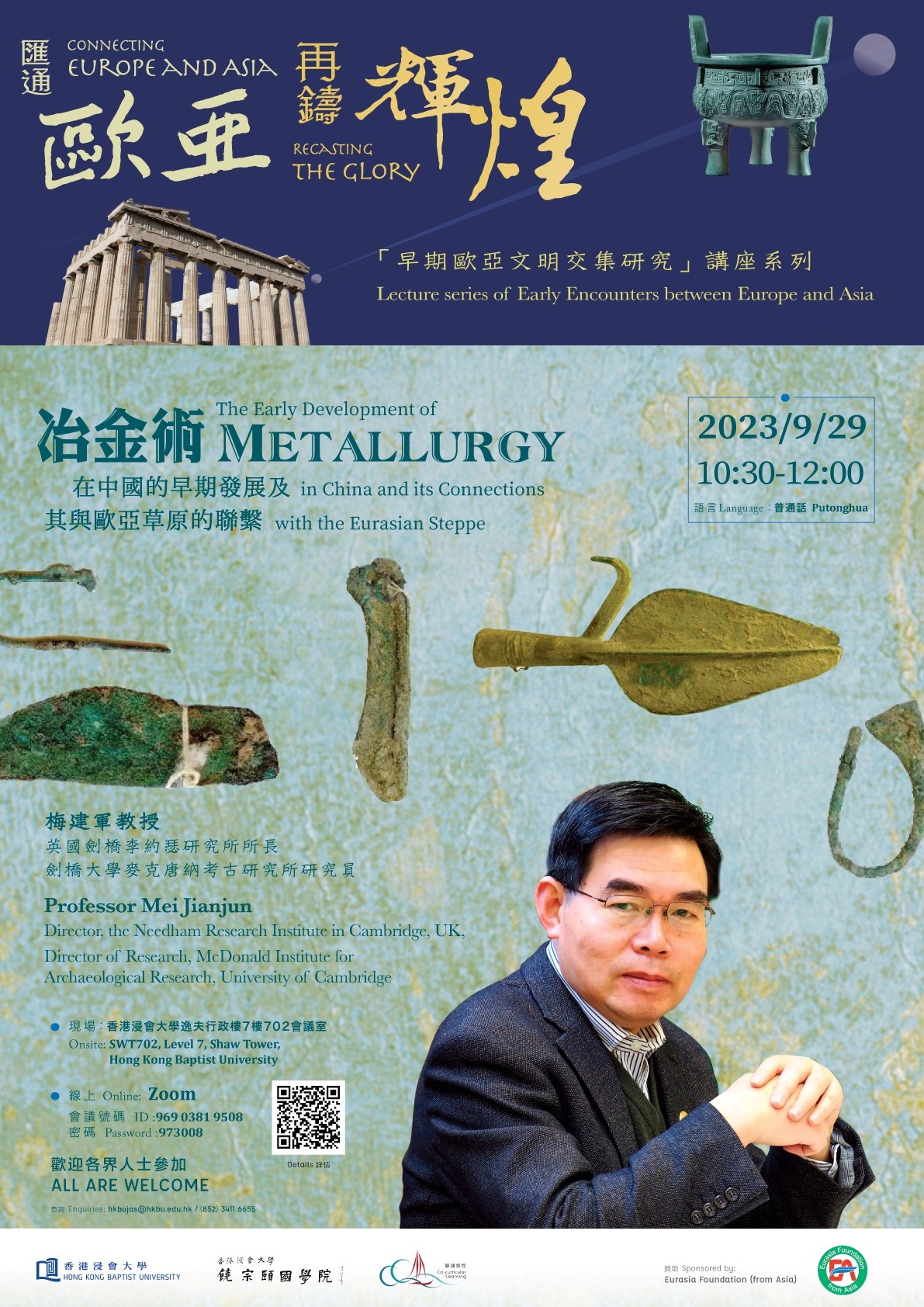
Connecting Europe and Asia, Recasting the Glory: Lecture series of Early Encounters between Europe and Asia
Lecture 3: The Early Development of Metallurgy in China and Its Connections with the Eurasian Steppe
2023/9/29 │ 10:30–2:00
Professor Mei Jianjun
Director, the Needham Research Institute in Cambridge, UK
Director of Research, Macdonald Institute for Archaeological Research, University of Cambridge
- Abstract: Were metallurgical technologies homegrown or did they come into China from outside? This question has consistently received the scrutiny of archaeologists and metallurgists. From the 1940s to the present, discussion has ebbed and flowed but reaching a definitive conclusion has proved difficult. Archaeological finds in recent years have furnished new evidence supporting a Chinese origin and outlined subsequent early developments, as well as providing new perspectives from which to view the issue and new avenues to investigate. Grounded in these discoveries, this paper devises a roadmap for systematic exploration and analysis of a proposed Chinese origin and its early development but considers that the weight of archaeological evidence still supports the view that metallurgical technologies entered China from the Eurasian steppe.
This paper focuses on the following three issues: 1. The advent of Old-World metallurgical technologies and their diffusion across the Eurasian steppe; 2. The excavation of early bronze artifacts and vestigial evidence of smelting and casting in northwest China; and 3. The development of early Chinese metallurgical technologies and their link to cultures of the Eurasian steppe. It considers that in the third millennium BCE, manufactured metal artifacts entered northwestern China from the Eurasian steppe, and relevant metallurgical technologies followed in their wake, and furthermore that in approximately the early second millennium BCE, they began a process of transformation into an indigenous practice. Subsequently, metallurgical technologies continued their diffusion eastwards entering north China and the central plains. This process of indigenous evolution gathered pace, especially given the stimulus of systems of Chinese ritual practice, leading to the formulation of a uniquely individual technology of composite earthenware mould casting, which in one fell swoop established a foundation for the magnificent culture of bronze artifacts of the Shang and Zhou dynasties.
- Language: Putonghua
- Summary (Recorded by Zhang Zixuan)
In his lecture ‘The Early Development of Metallurgy in China and Its Connections with the Eurasian Steppe’, Professor Mei Jianjun made copious citation of corroborating material in support of his argument. Through detailed evidence, he used ‘the technology for smelting metal’ to link the respective allure of both European and Asian civilisations. The lecture could be broadly divided into three parts:
Firstly, he introduced and discussed the discovery of the technology of smelting metal in the ‘Old World’ and its transmission across the Eurasian steppe. As a starting point, he outlined the classical scholarly conundrum of whether ‘the technology for smelting metal had its origin in a single location or in multiple centres’. Gordon Childe and Theodore A. Wertime can be counted as two of the most important figures who maintain the view of an origin from a single location. Those who hold the view of origins from multiple centres include Colin Renfrew. Immediately following on from this, Professor Mei discussed the issue of whether the discovery of the technology of smelting metal had been driven by technological aspirations or aesthetic requirements. Then, he introduced a synthesised theory of the wellspring of the technology for smelting metal and a refutation of it. Particularly worthy of note is a recent discovery in Eastern Europe of tin-bronze alloys dated to the mid-fifth millenium before the Common Era, which challenges the paradigm of a centre focused on Western Asia. At the same time, the flourishing and transmission of the technology for smelting metal on the Eurasian landmass is also a ‘hot topic’ to which particular attention is being paid in scholarly circles.
Finally, in the question-and-answer session that followed, Professor Shaughnessy raised the issue of ‘whether the metal smelting technology of Sanxingdui in Sichuan had a relationship to that of north-west China’. Professor Mei indicated that archaeologists had previously overemphasised the relationship between this technology in the Yangtze River floodplain and its occurrence in Sanxingdui, when in fact the relationship between north-west China and Sanxingdui in this respect is well worth noticing and considering.
- Lecture video
HKBUTube
Bilibili
This lecture series is sponsored by Eurasia Foundation (from Asia).